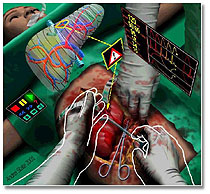 |
|
|
 |
||
| ||||||||||||||||||
|
NSF Announces $156 Million in Awards for Information
Technology Research
|
||||||||||||||||||
|
|
|
The National Science Foundation (NSF) today announced 309 awards designed to preserve America's position as the world leader of computer science and its applications. The projects will receive more than $156 million from NSF's Information Technology Research (ITR) priority area, which spurs fundamental research and innovative uses of IT in science and engineering.
Selected from over 2,000 competitive proposals, the newly funded activities include eight large projects that will each total between $5.5 million and $13.75 million over five years. Another 113 mid-sized projects will each total $1 million to $5 million for three to five years, and 188 smaller projects will receive up to $500,000 each for up to three years.
"NSF is proud to be a leader with these bold ITR projects," said NSF director Rita Colwell in a presentation today to the President's Information Technology Advisory Committee meeting, where she announced the awards. "Through long-term, high-risk research, we expect a wide range of positive results that will benefit the nation as a whole. Our objective is to support the development of software and IT services that will help scientists and engineers make the kind of discoveries that will eventually be applied by industry."
The program's main goals are to augment the nation's IT knowledge base and strengthen the IT workforce. Major subject areas include Systems Design and Implementation (including human-computer interfaces), People and Social Groups Interacting with IT (including economic and workforce implications), Information Management (including content/data analysis and informatics), Applications in Science and Engineering (including simulations and advanced computation) and Scalable Information Infrastructure (includes security, "tetherfree" computing and "teleimmersion").
For example, an ITR project at the University of California-Berkeley will develop "societal scale" information systems, aimed at solving complex problems related to energy, disaster response and education. The University of Kansas will deploy radar sensors at polar regions to collect and analyze real-time data about interactions between ice sheets, oceans and the atmosphere, helping to determine why sea levels have been rising for the past century.
Computer scientists and other researchers at Carnegie Mellon, Rice and Old Dominion universities will develop software for on-line simulations to constantly assimilate data from physical processes related to aerodynamics, energy, environment, geophysics, medicine and many other applications. These tools could yield far more accurate predictions than are possible with current technology.
Survivors of the Shoah Visual History Foundation is a non-profit organization that maintains over 116,000 hours of digitized video interviews with survivors and witnesses of the Holocaust. An ITR award will lead to speech-recognition software for cataloging this multimedia content, whose multilingual aspect poses special research challenges. New cross-language search capabilities will have broad implications for "metadata" -- defined as "data about data."
Clarkson University in New York will apply advanced IT for solid-state physics research, including the education of young scientists who will help develop ultra-fast quantum computers that use atomic-level processes to replace silicon chips. Oregon State University will lead an effort to assimilate massive amounts of data about oceans and the atmosphere. The team -- which includes computer scientists, oceanographers and civil engineers from six universities, a national laboratory and private industry -- will develop modular software to aid forecasting of weather, oceanic events, groundwater and geophysics.
"IT has already transformed our daily lives, yet its most significant impact so far may be in science and engineering," said Gary Strong, NSF program director for ITR. "These new NSF projects show that information technology is enabling new types of fundamental research not previously feasible, by helping to gather and make sense of a data avalanche that will solve countless mysteries about the world around us. Basic IT research is essential to progress in physical science, medicine, earthquake modeling, environmental studies and virtually every other field of study, as well."
NSF has also just kicked off its third annual ITR competition. The foundation's ITR budget request for fiscal 2002 is $217 million of additional funding, although the actual appropriation is yet to be determined by Congress.
![]()
For a searchable database of FY 2001 ITR awards, see: http://www.itr.nsf.gov/
NSF is an independent federal agency that supports fundamental research and education across all fields of science and engineering, with an annual budget of about $4.5 billion. NSF funds reach all 50 states, through grants to about 1,800 universities and institutions nationwide. Each year, NSF receives about 30,000 competitive requests for funding, and makes about 10,000 new funding awards.
Receive official NSF news electronically through the e-mail delivery system, NSFnews. To subscribe, send an e-mail message to listmanager@nsf.gov. In the body of the message, type "subscribe nsfnews" and then type your name. (Ex.: "subscribe nsfnews John Smith")
|
|

